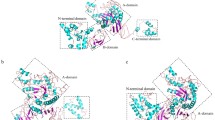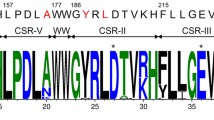Abstract
The functional and structural significance of the C-terminal region of Thermoanaerobacter ethanolicus 39E amylopullulanase (TetApu) was explored using C-terminal truncation mutagenesis. Comparative studies between the engineered full-length (TetApuM955) and its truncated mutant (TetApuR855) included initial rate kinetics, fluorescence and CD spectrometric properties, substrate-binding and hydrolysis abilities, thermostability, and thermodenaturation kinetics. Kinetic analyses revealed that the overall catalytic efficiency, k cat/K m, was slightly decreased for the truncated enzymes toward the soluble starch or pullulan substrate. Changes to the substrate affinity, K m, and turnover rate, k cat, varied in different directions for both types of substrates between TetApuM955 and TetApuR855. TetApuR855 exhibited a higher thermostability than TetApuM955, and retained similar substrate-binding ability and hydrolyzing efficiency against the raw starch substrate as TetApuM955 did. Fluorescence spectroscopy indicated that TetApuR855 retained an active folding conformation similar to TetApuM955. A CD-melting unfolding study was able to distinguish between TetApuM955 and TetApuR855 by the higher apparent transition temperature in TetApuR855. These results indicate that up to 100 amino acid residues, including most of the C-terminal fibronectin typeIII (FnIII) motif of TetApuM955, could be further removed without causing a seriously aberrant change in structure and a dramatic decrease in soluble starch and pullulan hydrolysis.






Similar content being viewed by others
References
Ausubel FM, Brent R, Kingston RE, Moore DD, Seidman JG, Smith JA, Struhl K (1993) Current protocols in molecular biology. Greene & Wiley-Interscience, New York
Boraston AB, Bolam DN, Gilbert HJ, Davies GJ (2004) Carbohydrate-binding modules: fine-tuning polysaccharide recognition. Biochem J 382:769–781
Bozonnet S, Jensen MT, Nielsen MM, Aghajari N, Jensen MH, Kramhøft B, Willemoe¨s M, Tranier S, Haser R, Svensson B (2007) The ‘pair of sugar tongs’ site on the non-catalytic domain C of barley α-amylase participates in substrate binding and activity. FEBS J 274:5055–5067
Bradford M (1976) A rapid and sensitive method for the quantitation of microgram quantities of protein utilizing the principle of protein-dye binding. Anal Biochem 72:248–254
Brown SH, Kelly RM (1993) Characterization of amylolytic enzymes, having both α-1,4 and α-1,6 hydrolytic activity, from the thermophilic archaea Pyrococcus furiosus and Thermococcus litoralis. Appl Environ Microbiol 59:2614–2621
Canganella F, Andrade CM, Antranikian G (1994) Characterization of amylolytic and pullulytic enzymes from thermophilic archaea and from a new Fervidobacterium species. Appl Microbiol Biotechnol 42:239–245
Chuang HH, Lin HY, Lin FP (2008) Biochemical characteristics of C-terminal region of recombinant chitinase from Bacillus licheniformis—implication of necessity for enzyme properties. FEBS J 275:2240–2254
Coutinho PM, Henrissat B (1999) Carbohydrate-active enzymes: an integrated database approach. In: Gilbert HJ, Davies G, Henrissat B, Svensson B (eds) Recent advances in carbohydrate bioengineering. The Royal Society of Chemistry, Cambridge, pp 3–12
Dong G, Vieille C, Zeikus JG (1997) Cloning, sequencing, and expression of the gene encoding amylopullulanase from Pyrococcus furiosus and biochemical characterization of the recombinant enzyme. Appl Environ Microbiol 63:3577–3584
Erra-Pujada M, Debeire P, Duchiron F, O’ Donohue MJ (1999) The type II pullulanase of Thermococcus hydrothermalis: molecular characterization of the gene and expression of the catalytic domain. J Bacteriol 181:3284–3287
Erra-Pujada M, Chang-Pi-Hin F, Debeire P, Duchiron F, O’Donohue MJ (2001) Purification and properties of the catalytic domain of the thermostable pullulanase type II from Thermococcus hydrothermalis. Biotechnol Lett 23:1273–1277
Gilkes NR, Henrissat B, Kilburn DG, Miller RC Jr, Warren RAJ (1991) Domains in microbial β-1,4-glycanases: sequence conservation, function, and enzyme families. Microbiol Rev 55:303–315
Hansen CK (1992) Fibronectin type III-like sequences and a new domain type in prokaryotic depolymerases with insoluble substrates. FEBS Lett 305:91–96
Henrissat B (1991) A classification of glycosyl hydrolases based on amino acid sequence similarities. Biochem J 280:309–316
Imamura H, Fushinobu S, Yamamoto M, Kumasaka T, Jeon BS, Wakagi T, Matsuzawa H, (2003) Crystal Structures of 4-α-Glucanotransferase from Thermococcus litoralis and Its Complex with an Inhibitor J. Biol Chem 278:19378–19386
Janecek S (2005) Amylolytic families of glycoside hydrolases: focus on the family GH-57. Biologia 60(Suppl. 16):177–184
Kataeva IA, Ronald DS, Ashit S, Larry TW, Xin-Liang L, Lars GL (2002) The fibronectin type 3-like repeat from the Clostridium thermocellum cellobiohydrolases CbhA promotes hydrolysis of cellulose by modifying its surface. Appl Environ Microbiol 68:4292–4300
Kuriki T, Imanaka T (1999) The concept of the alpha-amylase family: structural similarity and common catalytic mechanism. J Biosci Bioeng 87:557–565
Laemmli UK (1970) Cleavage of structural proteins during the assembly of the head of bacteriophage T4. Nature 227:680–685
Lee SP, Morikawa M, Takagi M, Imanaka T (1994) Cloning of the aapT gene and characterization of its product, alpha amylase-pullulanase (AapT), from thermophilic and alkaliphilic Bacillus sp. strain XAL601. Appl Environ Microbiol 60:3764–3773
Lemaire M, Ohayon H, Gounon P, Fujino T, Beguin P (1995) OlpB, a new outer layer protein of Clostridium thermocellum, and binding of its S-layer-like domain to components of the cell envelope. J Bacteriol 177:2451–2459
Lin FP, Leu KL (2002) Cloning, expression and characterization of the thermostable region of amylopullulanase gene from Thermoanaerobacter ethanolicus 39E. Appl Biochem Biotech 97:33–44
Little E, Bork P, Doolittle RF (1994) Tracing the spread of fibronectin type III domains in bacterial glycohydrolases. J Mol Evol 39:631–643
Lo HF, Lin LL, Chiang WY, Chie MC, Hsu WH,Chang CT (2002) Deletion analysis of the C-terminal region of the α-amylase of Bacillus sp. strain TS-23. Arch Microbiol 178:115–123
Machovic M, Svensson B, MacGregor EA, Janecek S (2005) A new clan of CBM families based on bioinformatics of starch-binding domains from families CBM20 and CBM21. FEBS J 272:5497–5513
MacGregor EA, Janecek S, Svensson B (2001) Relationship of sequence and structure to specificity in the alpha-amylase family of enzymes. Biochim Biophys Acta 1546:1–20
Marmur J (1961) A procedure for the isolation of deoxyribonucleic acid from microorganisms. J Mol Biol 3:208–218
Mathupala SP, Lowe SE, Podkovyrov SM, Zeikus JG (1993) Sequencing of the amylopullulanase (apu) gene of Thermoanaerobacter ethanolicus 39E, and identification of the active site by site-directed mutagenesis. J Biol Chem 268:16332–16344
Mathupala SP, Zeikus JG (1993) Improved purification and biochemical characterization of extracellular amylopullulanase from Thermoanaerobacter ethanolicus 39E. Appl Microbiol Biotechnol 39:487–493
Melasniemi H, Paloheimo M, Hemio L (1990) Nucleotide sequence of the alpha–amylase-pullulanase gene from Clostridium thermohydrosulfuricum. J Gen Microbiol 136:447–454
Olabarria G, Carrascosa JL, de Pedro M, Berenguer J (1996) A conserved motif in S-layer proteins is involved in peptidoglycan binding in Thermus thermophilus. J Bacteriol 178:4765–4772
Robert X, Haser R, Gottschalk TE, Ratajczak F, Driguez H, Svensson B, Aghajari N (2003) The structure of barley α-amylase isozyme 1 reveals a novel role of domain C in substrate recognition and binding: A pair of sugar tongs. Structure 11:973–984
Rodriguez-Sanoja R, Oviedo N, Sanchez S (2005) Microbial starch-binding domain. Curr Opin Microbiol 8:260–267
Rudiger A, Jorgensen PL, Antranikian G (1995) Isolation and characterization of a heat-stable pullulanase from the hyperthermophilic archaeon Pyrococcus woesei after cloning and expression of its gene in Escherichia coli. Appl Environ Microbiol 61:567–575
Sambrook J, Fritsch EF, Maniatis T (1989) Molecular cloning: a laboratory manual. Cold Spring Harbor Laboratory Press, Cold Spring Harbor
Sára M, Egelseer EM, Dekitsch C, Sleytr UB (1998) Identification of two binding domains, one for peptidoglycan and another for a secondary cell wall polymer, on the N-terminal part of the S-layer protein SbsB from Bacillus stearothermophilus PV72/p2. J Bacteriol 180:6780–6783
Suzuki K, Taiyoji M, Sugawara N, Nikaidou N, Henrissat B, Watanabe T (1999) The third chitinase gene (chiC) of Serratia marcescens 2170 and the relationship of its product to other bacterial chitinases. Biochem J 343:587–596
Takami H, Takaki Y, Chee GJ, Nishi S, Shimamura S, Suzuki H, Matsui S, Uchiyama I (2004) Thermoadaptation trait revealed by the genome sequence of thermophilic Geobacillus kaustophilus. Nucleic Acids Res 32:6292–6303
van der Maarel MJ, van der Veen B, Uitdehaag JC, Leemhuis H, Dijkhuizen L (2002) Properties and applications of starch-converting enzymes of the alpha-amylase family. J Biotechnol 94:137–155
Vieille C, Zeikus JG (2001) Hyperthermophilic enzymes: sources, uses, and molecular mechanisms for thermostability. Microbiol Mol Biol Rev 65:1–43
Watanabe T, Ito Y, Yamada T, Hashimoto M, Sekine S, Tanaka H (1994) The roles of C-terminal domain and type III domains of chitinase A1 from Bacillus circulans WL-12 in chitin degradation. J Bacteriol 176: 4465–4472
Watanabe T, Ariga Y, Sato U, Toratani T, Hashimoto M, Nikaidou N, Kezuka Y, Nonaka T, Sugiyama J (2003) Aromatic residues within the substrate-binding cleft of Bacillus circulans chitinase A1 are essential for hydrolysis of crystalline chitin. Biochem J 376:237–244
Zona R, Chang-Pi-Hin F, O’Donohue MJ, Janecek S (2004) Bioinformatics of the glycoside hydrolase family 57 and identification of catalytic residues in amylopullulanase from Thermococcus hydrothermalis. Eur J Biochem 271:2863–2872
Acknowledgments
We thank Dr. Chin-Pan Chen of the Institute of Biomedical Science, Academia Sinica, for his considerable assistance in the CD spectroscopy analyses. This work was supported by the National Science Council, Taiwan (grant NSC 94-2313-B019-029) and the Center for Marine Bioscience and Biotechnology (CMBB), National Taiwan Ocean University (grant 99529001A8).
Author information
Authors and Affiliations
Corresponding author
Additional information
Communicated by K. Horikoshi.
Rights and permissions
About this article
Cite this article
Lin, HY., Chuang, HH. & Lin, FP. Biochemical characterization of engineered amylopullulanase from Thermoanaerobacter ethanolicus 39E-implicating the non-necessity of its 100 C-terminal amino acid residues. Extremophiles 12, 641–650 (2008). https://doi.org/10.1007/s00792-008-0168-4
Received:
Accepted:
Published:
Issue Date:
DOI: https://doi.org/10.1007/s00792-008-0168-4




